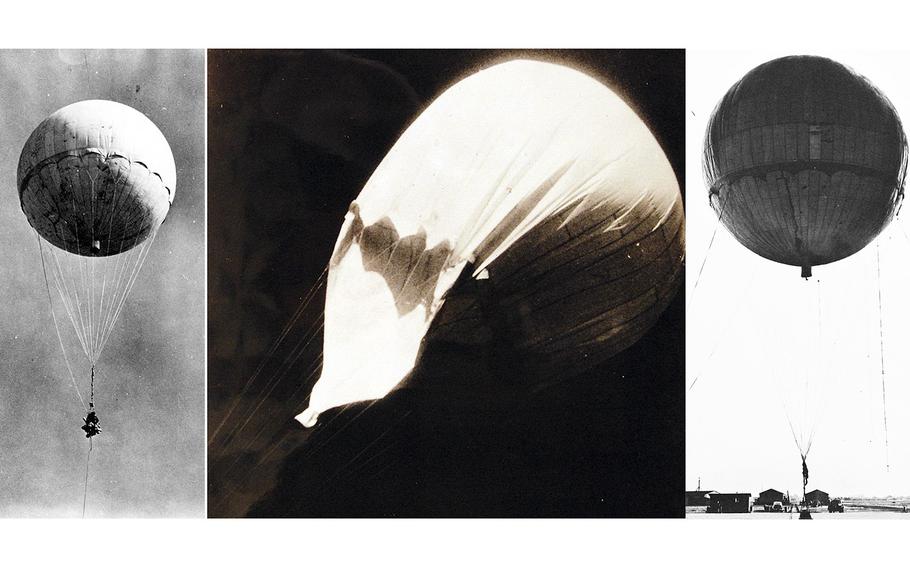
At left: A Japanese fire balloon made of mulberry paper was re-inflated at Moffett Field, Calif., after it had been shot down by a Navy aircraft on Jan. 10, 1945. Center: a World War II era Japanese Fu-Go balloon is seen in a photograph taken by a pursuing Bell P-63 “Kingcobra” aircraft. The headquarters of 4th Air Force, San Francisco, released the photo on Feb. 8, 1946. At right: A Japanese Fu-Go balloon is re-inflated for laboratory tests at a California base, after It was recovered in Alturas, Calif., on Jan. 10, 1945. (Wikimedia Commons)
(Tribune News Service) — In late 1944, the Japanese military began launching 9,000 unmanned bomb-carrying balloons across the Pacific to bombard the West Coast.
Most of the balloon bombs fell harmlessly in the ocean, but a few landed in the Northwest, setting off a few minor forest fires. Only about 300 balloon bombs landed in the U.S. Canada, and Mexico.
Of the known locations of balloon bomb landings, only one was reported in San Diego County, according to Ross Coen, a history professor and the author of “Fu-Go: The Curious History of Japan’s Balloon Bomb Attack on America.”
A local rancher named Everett Campbell and one of his ranch hands observed a pear-shaped balloon land near his Julian ranch on Jan. 31, 1945, according to Coen.
The Julian balloon landing came after the government’s Office of Censorship had ordered a media blackout of any news about the balloons.
The news blackout stayed in effect until May 5, 1945, when a mother and five children were killed in Oregon when a balloon bomb they dragged from the woods exploded. Details remained classified until the war ended.
From The San Diego Union Archives, Friday, Aug. 17, 1945
Enemy Balloon Found in S.D. County Studied
At least one and possibly two of the thousands of bomb-carrying paper balloons the Japanese are believed to have sent against the United States fell in San Diego county. Relaxation of censorship permitted this disclosure here for the first time yesterday.
In addition, at least two of the balloons are believed to have passed over the county, carried farther east by the same winds that the enemy cleverly calculated would transport the gas-filled paper bags from Japan across thousands of miles of Pacific ocean to the continental United States.
One balloon was recovered intact in the vicinity of Cedar Creek, six miles southwest of Julian, last Jan. 31. A fisherman found it and the device was studied in turn by the federal bureau of investigation and the office of naval intelligence.
SECOND BAG LOST
The other balloon was seen flying low over El Capitan dam. It rose, however, before supposedly falling in the rough mountain area beyond Descanso. It is believed to be still there. A search failing to find it was abandoned.
Neither of the balloons did any apparent damage. A block of picric acid, somewhat larger than a pound of butter and possibly intended to destroy the device to prevent study of its intricate machinery, was found on the Cedar Creek balloon.
The balloon that fell in Cedar creek was described as having a bag 33 feet in diameter, composed of three-ply laminated rice paper, which is very tough and retains gas better than cloth. The control mechanism and bomb load were carried in a “skirt” suspended by paper rope strands. The bag was filled with inflammable gas.
The bomb mechanism was controlled by barometers and an electric battery, actuating a series of switches that operated when the balloon descended to a determined altitude. At each descent ballast bags were dumped as the balloon crossed the ocean. The final series of descents dropped incendiary bombs, of which there were four, and an anti-personnel bomb. Usually the balloons also carried a demolition charge intended to destroy the device at the end.
The balloons normally traveled at an elevation of 30,000 to 40,000 feet. Most of them fell in the northern parts of the Pacific coast.
STORM WIND BLAMED
Belief that the balloons were blown this way by a storm that swept the ocean areas off San Diego last winter also was expressed. About that time several others were sighted over this area but no other landings were reported.
One reportedly came down in the ocean not far north of San Diego and others landed at Van Nuys and Saticoy.
Navy planes chased at least one of the balloons over the San Diego mountains and into Arizona.
Aerial strategy in grounding the balloons that were observed was to fly close to them in planes and by air disturbance drive them to earth.
OFTEN MISTAKEN
Many weather balloons were mistaken here for Japanese balloons, especially after military authorities instituted a word-of-mouth campaign warning the public of the potential dangers associated with the apparatus. Six persons who tampered with a balloon near Lakeview, Ore., were killed by the explosion.
San Diego appeared to be out of the main “invasion” line of the balloons, and it was felt here that only those that came in the wake of the January storm reached southern California.
Results of F.B.I. and Navy studies of the Cedar Creek balloon – one of the few that landed in such perfect condition – were placed in the highly secret category until the war ended.
©2023 The San Diego Union-Tribune.
Visit sandiegouniontribune.com.
Distributed by Tribune Content Agency, LLC.